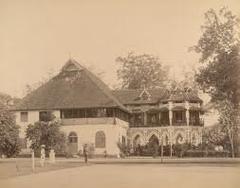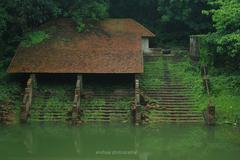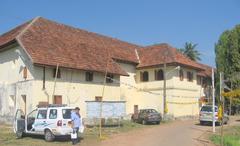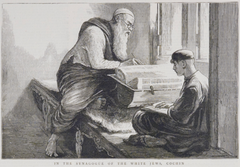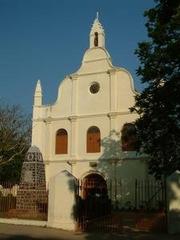Discovering the Wonders of Kochi, Ernakulam District, India
Date: 13/08/2024
A Captivating Introduction to Kochi
Welcome to Kochi, a city where the past and present dance in perfect harmony, where ancient Chinese fishing nets sway in the breeze, and the aroma of spices fills the air. Imagine strolling down cobbled streets lined with colonial-era buildings, each whispering tales of bygone empires. Nestled on the southwest coast of India in Kerala, Kochi is not just a city; it’s a vibrant tapestry woven from centuries of history, culture, and natural beauty. Known to the Greeks, Romans, Jews, Arabs, and Chinese as a significant trading hub, Kochi’s rich history dates back to ancient times (New World Encyclopedia). Whether you’re exploring the ancient Mattancherry Palace, marveling at the unique Chinese fishing nets, or soaking in the serene backwaters, Kochi offers a sensory feast that’s hard to match. So, let’s embark on a journey through time and senses, uncovering the secrets and stories that make Kochi the jewel of Kerala’s crown.
Table of Contents
- Exploring the Historical Significance of Kochi, Ernakulam District, India
- Discovering Kochi: The Venice of the East - A Geographical and Climatic Adventure
- Unveiling Kochi: A Journey Through Time and Senses
- Marine Drive, Kochi
- Mattancherry Palace
- Veeranpuzha Lake and Beach
- Ernakulathappan Temple
- Museum of Kerala History
- Vypin Beach
- Kodanad Elephant Training Centre
- Kochi-Muziris Biennale
- Fort Kochi Beach
- Willingdon Island
- Chinese Fishing Nets
- Jew Town
- Indian Naval Maritime Museum
- Mangalavanam Bird Sanctuary
- Chottanikkara Temple
- Subhash Park
- Greenix Village
- Pierce Leslie Bungalow
- Pallipuram Fort
- Thrikkakkara Vamana Moorthy Temple
- Sunset Cruise
- Ayurvedic Massage in Kochi
Exploring the Historical Significance of Kochi, Ernakulam District, India
Ancient and Medieval History
Kochi, also known as Cochin, has a rich history that dates back to ancient times. The city was known to the Greeks, Romans, Jews, Arabs, and Chinese as a significant trading hub. The earliest documented references to Kochi can be found in the writings of the Chinese voyager Ma Huan, who visited the city in the 15th century as part of Admiral Zheng He’s treasure fleet (New World Encyclopedia). Italian traveler Niccolò Da Conti also mentioned Kochi in his accounts from 1440.
Kochi rose to prominence as a trading center after the massive flooding of the Periyar River in 1341, which destroyed the port at Kodungallur (Cranganore). This natural disaster shifted the focus of maritime trade to Kochi, making it an essential port along the spice route (Outlook Traveller).
Colonial Era
Portuguese Rule
The Portuguese were the first Europeans to establish a colonial settlement in Kochi. In 1503, they occupied the city and made it the capital of Portuguese India until 1530, when they shifted the capital to Goa (New World Encyclopedia). The Portuguese influence is still evident in the city’s architecture and culture. Notably, Vasco da Gama, the first European explorer to reach India by sea, was buried in St. Francis Church in Fort Kochi until his remains were returned to Portugal in 1539 (New World Encyclopedia).
Dutch and British Rule
The Dutch took over Kochi from the Portuguese in 1663. They allied with the Zamorins to conquer the city and left a lasting impact on its architecture and trade practices. The Dutch Palace, also known as Mattancherry Palace, is a significant landmark from this period. It was originally built by the Portuguese and later renovated by the Dutch (Twodaystrip).
In 1773, the Mysore King Hyder Ali extended his conquest to Kochi, forcing it to become a tributary of Mysore. The British eventually took control of Kochi, and it remained under British rule until India gained independence in 1947. Kochi was the first princely state to willingly join the Indian Union (New World Encyclopedia).
Modern Era
Economic Growth and Development
Kochi experienced decades of economic stagnation after independence until 2003, when it entered a period of rapid economic growth. The city has since become a commercial hub, with significant developments in information technology, tourism, and international trade (New World Encyclopedia). Kochi is now one of the fastest-growing second-tier metros in India, although it continues to struggle with urbanization challenges such as traffic congestion and environmental degradation.
Cultural Melting Pot
Successive waves of migration over millennia have made Kochi a cultural melting pot. The city’s architecture, cuisine, and way of life reflect the influences of Portuguese, Dutch, and British settlers, as well as traders from various parts of the world (Outlook Traveller). This multicultural identity is one of Kochi’s most captivating aspects, offering visitors a unique blend of tradition and modernity.
Key Historical Landmarks
Fort Kochi
Fort Kochi is a seaside area known for its colonial architecture and Chinese fishing nets. The cobbled streets are lined with colonial-era buildings, charming cafes, and vibrant street art, creating an atmosphere of timeless beauty (Twodaystrip). The Chinese fishing nets, introduced by traders from the court of Kublai Khan, are a unique feature of the area and a lifeline for local fishermen.
Mattancherry Palace
Also known as the Dutch Palace, Mattancherry Palace is a must-visit for history enthusiasts. The palace features a blend of European and traditional Kerala architecture and houses a museum with exhibits on the history of the region (Twodaystrip).
St. Francis Church
St. Francis Church is one of the oldest European churches in India. It is historically significant as the original burial site of Vasco da Gama. The church’s simple yet elegant architecture reflects the colonial influences that have shaped Kochi’s history (New World Encyclopedia).
Paradesi Synagogue
Located in Jew Town, the Paradesi Synagogue is the oldest active synagogue in the Commonwealth of Nations. Built in 1568, it is a testament to the Jewish community’s long-standing presence in Kochi. The synagogue features beautiful Belgian glass chandeliers, a gold pulpit, and hand-painted Chinese tiles (Kerala Scapes).
Visitor Tips
Best Time to Visit
The best time to visit Kochi is during the winter months from October to February when the weather is pleasant. This period also coincides with several cultural festivals, offering visitors a chance to experience the local traditions and festivities.
Getting Around
Kochi has a well-developed public transportation system, including buses, auto-rickshaws, and ferries. The recently launched water metro system connects various islands and offers a unique way to explore the city (Conde Nast Traveller).
Local Cuisine
Kochi’s cuisine is a delightful blend of traditional Kerala flavors and colonial influences. Visitors should not miss trying local dishes such as appam with stew, fish curry, and the famous Kerala sadya. The spice markets in Fort Kochi offer a sensory feast with a wide range of aromatic spices (Kerala Scapes).
Accommodation
Kochi offers a range of accommodation options to suit different budgets, from luxury hotels to budget guesthouses. Staying in Fort Kochi provides easy access to many historical landmarks and a chance to experience the area’s unique charm.
Discovering Kochi: The Venice of the East - A Geographical and Climatic Adventure
Location and Topography: A Coastal Symphony
Kochi, also known as Cochin, is your gateway to a tropical paradise. Situated between latitudes 9.48° and 10.50° N and longitudes 76.5° and 76.58° E, this coastal gem boasts a seacoast stretching approximately 30 miles. Picture this: a rich network of backwaters, declared as National Waterways, weaving through islands like Ernakulam, Mattancheri, Fort Cochin, Willingdon Island, Vypin Island, and Gundu Island. Willingdon Island, by the way, is the largest artificial island in India, created by dredging the Vembanad Lake under the supervision of Lord Willingdon. Fascinating, isn’t it?
Soil and Rock Composition: The Earth Beneath Our Feet
Dig a little deeper, and you’ll find that Kochi’s soil primarily consists of alluvium, teri’s, and brown sands, with hydromorphic saline soils near the backwaters. The region’s major rock types include Archaean-basic dykes, charnockites, and gneisses. It’s like nature’s own art gallery!
Climate: Tropical Monsoon Magic
Kochi experiences a tropical monsoon climate, categorized under Köppen’s climate classification. Forget harsh extremities! Here, surface temperatures range between a comfortable 20°C to 35°C (68°F to 95°F). The record high? A toasty 38°C. The record low? A cool 17°C.
Monsoon Seasons: Nature’s Symphony
Kochi dances to the rhythm of two monsoon seasons:
- South-West Monsoon (June to September): Expect heavy rains accompanied by thunder. This is when Kochi’s greenery truly comes alive.
- North-West Monsoon (October to December): Light showers and a refreshing ambiance.
With an average annual rainfall of about 350 cm and 132 rainy days per year, it’s a lush, green wonderland.
Monthly Climate Patterns: A Year-Round Experience
Temperature
March is the warmest month, averaging 28.2°C (82.8°F), while August cools down to 25.4°C (77.8°F).
Precipitation
January is the driest month with just 22 mm (0.9 inches) of rain, but June turns things around with a whopping 568 mm (22.4 inches).
Humidity
Feel the humidity peak in July at 89.14% and dip to 73.56% in February.
Flora and Fauna: A Tropical Wonderland
Kochi’s flora is a tropical dream. Picture Launaea, Ipomoea, Portulaca, Hydrocotyle, Spinifex, Lippia, Moniera, Cynodon, Digitaria, and Cyperus flourishing around you. Mangroves add a unique touch to this verdant landscape.
Water Bodies: The Lifelines of Kochi
Seven major rivers from the Western Ghats flow through Kochi, including the majestic Periyar River, Kerala’s longest. These rivers crisscross the midlands, lowlands, and coastal areas before joining the Arabian Sea.
Best Time to Visit: When to Say Hello to Kochi
The ideal time to visit Kochi is during the drier months from January to February and from September to early February. These months offer mild weather, perfect for exploration. The monsoon season from May to July, though beautiful, is best avoided due to heavy rains. Summer can get quite hot, with temperatures soaring up to 40°C.
Unique Climatic Features: Kochi’s Claims to Fame
- Water Metro System: Did you know Kochi is the only city in India with a water metro system? It’s the world’s largest electric boat metro transportation infrastructure.
- Solar-Powered Airport: Cochin International Airport is the first in the world to run entirely on solar energy. Talk about eco-friendly!
Summary of Climatic Data: Quick Facts
- Average Annual Rainfall: 350 cm
- Average Rainy Days Annually: 132 days
- Record High Temperature: 38°C
- Record Low Temperature: 17°C
- Warmest Month: March (28.2°C)
- Coldest Month: August (25.4°C)
- Wettest Month: June (568 mm)
- Driest Month: January (22 mm)
- Highest Humidity: July (89.14%)
- Lowest Humidity: February (73.56%)
For more detailed climatic data, visit Climate-Data.
Kochi’s Hidden Treasures: Local Secrets
- Secret Beaches: Explore the secluded Cherai Beach, a local favorite.
- Quirky Customs: Don’t miss the Cochin Carnival, a vibrant blend of cultures.
- Insider Tips: Try the local street food—especially banana chips and appam!
Cultural Context and Etiquette: When in Kochi…
- Customs: Remove your shoes before entering homes and temples.
- Social Norms: Address locals with a respectful ‘Namaste’.
Practical Information with a Twist
- Infographic: Think of Kochi’s climate as a dance—monsoon Tango, summer Salsa, and winter Waltz.
- Rhyme: When in doubt, don’t pout—Kochi’s climate will sort it out!
Pop Culture References
- Movies: Remember ‘Salaam Bombay’? Some scenes were filmed here.
- Books: Arundhati Roy’s ‘The God of Small Things’ is set in Kerala.
- Songs: Listen to ‘Kerala’ by Bonobo for a musical journey.
Time-Based Itineraries: Choose Your Adventure
- Historical Explorer: Fort Kochi to Mattancheri in a day!
- Nature Lover: Backwaters to beaches in one magical trip.
Local Lingo Lessons: Speak Like a Local
- Key Phrases: ‘Namaskaram’ (Hello), ‘Nanni’ (Thank you).
- Funny Usage: Try saying ‘Ente Kochi’ (My Kochi) with pride!
Seasonal Highlights: Kochi Through the Year
- January: Cochin Carnival
- June: Monsoon Magic
- August: Onam Celebrations
Myth Busting and Surprises
- Myth: Kochi is just a port city. Reality: It’s a cultural hotspot!
- Surprise: Kochi has an ancient synagogue—one of the oldest in the Commonwealth.
Storytelling Elements: Tales of Kochi
- Historical Event: The arrival of Vasco da Gama.
- Local Legend: The story of the Chinese fishing nets.
FAQ: Your Kochi Questions Answered
- Q: What’s the best way to get around? A: Try the local ferries and auto-rickshaws.
- Q: Is Kochi safe for solo travelers? A: Absolutely! Just follow common safety practices.
Unveiling Kochi: A Journey Through Time and Senses
Marine Drive, Kochi: A Stroll Through Serenity
Feel the cool breeze on your face as you stroll along Marine Drive, with the aroma of freshly caught fish wafting from nearby stalls and the sound of waves gently lapping against the shore. The Rainbow Hanging Bridge is perfect for a vibrant morning or evening walk. Pro tip: Catch the sunrise or sunset here for a mesmerizing view (Holidify).
Mattancherry Palace: A Time Capsule of Art and History
Also known as the Dutch Palace, Mattancherry Palace was built by the Portuguese in 1545. The palace is a treasure trove of Kerala murals depicting Hindu temple art, portraits, and exhibits of the Rajas of Kochi. Step in to feel the pulse of history (Yometro).
Veeranpuzha Lake and Beach: Serenity By the Shore
Veeranpuzha Lake, an extension of the Vembanad Lake, offers serene views and a tranquil environment. Nearby, Veeranpuzha Beach beckons with golden sands and a peek into the local fishing community’s daily life. Watch fishermen at work and soak in the rural vibe (Holidify).
Ernakulathappan Temple: Where Divinity Meets Devotion
In the heart of Kochi lies Ernakulathappan Temple, an ancient Shiva temple within Durbar Hall Ground. Thissite is a beacon for devotees and tourists alike, offering a spiritual retreat amidst the city bustle (Yometro).
Museum of Kerala History: A Walk Through Time
The Museum of Kerala History offers a compelling overview of the state’s cultural and historical heritage. With life-size statues, dioramas, and audio-visual presentations, it narrates Kerala’s journey from ancient times to the modern era (Yometro).
Vypin Beach: An Island Escape
Vypin Beach, located on Vypin Island, is a scenic blend of golden sands and blue waters. Accessible via a bridge from the mainland, the beach offers a unique mix of natural beauty and historical significance (Holidify).
Kodanad Elephant Training Centre: Up Close with Gentle Giants
Near the southern banks of the Periyar River, Kodanad Elephant Training Centre invites you to experience an ‘Elephant Kraal,’ a mini zoo, and elephant rides amidst towering mountains. It’s a must-visit for animal lovers (Holidify).
Kochi-Muziris Biennale: Art Meets Heritage
The Kochi-Muziris Biennale is an international exhibition of contemporary art, featuring works by artists from around the globe. This event, held at heritage properties and public spaces across Kochi, is a significant highlight in the global art calendar (Holidify).
Fort Kochi Beach: Tranquility by the Arabian Sea
Fort Kochi Beach is a serene spot adjoining the Arabian Sea, famous for its beautiful sidewalk and historical fort. Ideal for morning and evening walks, it offers a peaceful retreat (Holidify).
Willingdon Island: A Man-Made Marvel
Willingdon Island, one of India’s largest human-made islands, is a hub of activity, linking Kochi port with other national and international ports. Named after Lord Willingdon, it offers scenic views of the surrounding waters (Holidify).
Chinese Fishing Nets: A Symbol of Kochi
The iconic Chinese fishing nets, or Cheena vala, are a testament to Kochi’s diverse cultural heritage. These large, fixed fishing nets create a stunning silhouette against the sunset, making for a perfect photo op (Holidify).
Jew Town: A Mosaic of Cultures
One of the oldest parts of Kochi, Jew Town is renowned for the Paradesi Synagogue and its narrow alleys filled with antique shops, spice markets, and cafes. This area is a cultural mosaic rich in history (Holidify).
Indian Naval Maritime Museum: Maritime Heritage Unveiled
Showcasing India’s rich maritime heritage, the Indian Naval Maritime Museum on the INS Dronacharya premises is a tribute to the country’s naval history and its European trade links (Holidify).
Mangalavanam Bird Sanctuary: A Bird Watcher’s Paradise
Located in the heart of Kochi, Mangalavanam Bird Sanctuary is a haven for bird watchers and nature enthusiasts. Home to a variety of bird species and a unique mangrove ecosystem, it’s a slice of nature in the city (Holidify).
Chottanikkara Temple: A Marvel of Craftsmanship
In Kakkanad, the Chottanikkara Temple is revered for its stunning architecture and the craftsmanship of the vishwakarma sthapathis (wooden sculptors). It attracts numerous devotees and tourists year-round (Holidify).
Subhash Park: A Breath of Fresh Air
Overlooking the serene backwaters of Vembanad Lake and Kochi Harbour, Subhash Park, also known as Subhash Chandra Bose Park, is a perfect spot for relaxation and leisure activities (Holidify).
Greenix Village: A Cultural Extravaganza
Greenix Village is a cultural complex showcasing Kerala’s traditional art forms, including Kathakali, Kalaripayattu, and classical music. It offers daily performances, workshops, and exhibitions for an immersive cultural experience (Holidify).
Pierce Leslie Bungalow: Colonial Charm
Established in 1862, the Pierce Leslie Bungalow is a colonial mansion that blends Portuguese and Dutch architectural styles. Once the office of coffee merchants, it’s now a historical landmark in Kochi (Holidify).
Pallipuram Fort: A European Relic
On Vypeen Island, Pallipuram Fort is the oldest surviving European monument in India, built by the Portuguese in 1503. Surrounded by lush greenery, it offers a glimpse into early European influences in India (Holidify).
Thrikkakkara Vamana Moorthy Temple: Festive Splendor
Dedicated to Lord Vamana, an incarnation of Vishnu, Thrikkakkara Vamana Moorthy Temple is known for its architectural beauty and significance, especially during the Onam festival (Holidify).
Sunset Cruise: Sail into Serenity
Embark on a sunset cruise along the Arabian waters, starting from Marine Drive and covering Fort Kochi, Chinese fishing nets, Mattancherry, Bolgatty Island, and more. Experience the breathtaking sunset over the Arabian Sea (Holidify).
Ayurvedic Massage in Kochi: Rejuvenate and Revive
Kochi boasts numerous Ayurvedic centers offering massages that promise relaxation and rejuvenation. Based on traditional practices, these massages provide a unique sense of well-being (Holidify).
Call to Action
Kochi is more than just a picturesque city; it’s a living testament to centuries of cultural amalgamation and historical significance. From its roots as an ancient trading hub known to Greeks, Romans, and Arabs, to its colonial past under Portuguese, Dutch, and British rule, Kochi has evolved into a modern metropolis while retaining its unique charm (Outlook Traveller). The city’s diverse cultural heritage, evident in its architecture, cuisine, and vibrant arts scene, makes it a captivating destination for any traveler. Whether you’re wandering through the historical lanes of Fort Kochi, relaxing on the serene beaches of Vypin Island, or participating in the vibrant Kochi-Muziris Biennale, Kochi promises an unforgettable experience. Ready to uncover Kochi’s secrets? Download Audiala and let our expertly crafted audio guides lead you on a journey through this enchanting city. With Audiala, you’ll discover hidden gems and expert insights that make Kochi come alive in ways you never imagined.
References
- New World Encyclopedia, n.d. Kochi, India
- Outlook Traveller, n.d. City Guide: All About Kochi
- Twodaystrip, n.d. Historical Landmarks of Kochi, Kerala
- Conde Nast Traveller, n.d. One of Asia’s Best Places to Visit in 2024
- Kerala Scapes, n.d. Exploring the Cultural Heritage of Fort Kochi
- Holidify, n.d. Things to do in Kochi
- Yometro, n.d. Best Places to Visit in August in Kochi
- Climate-Data, n.d. Ernakulam Climate Data































